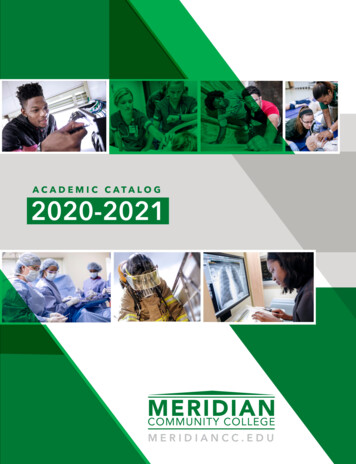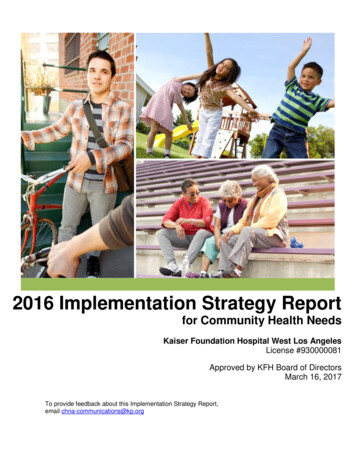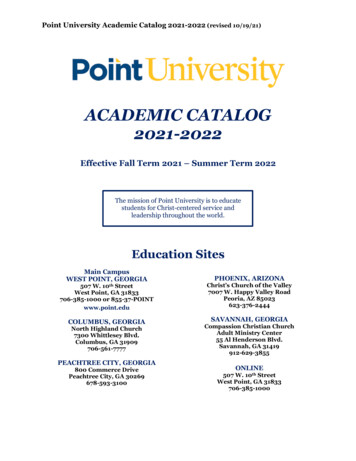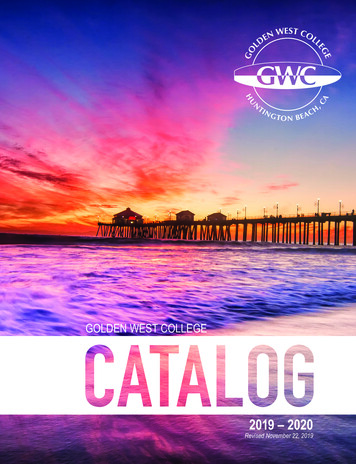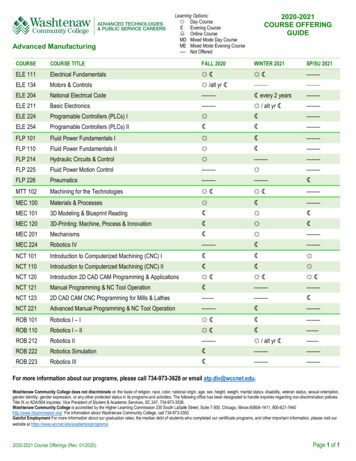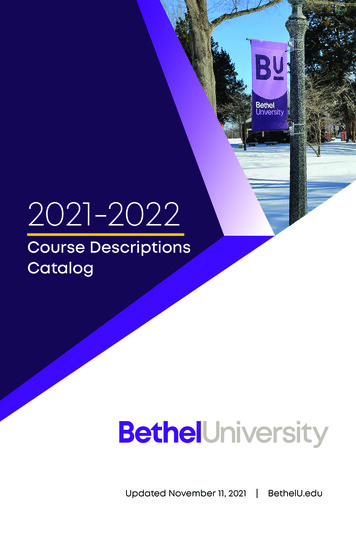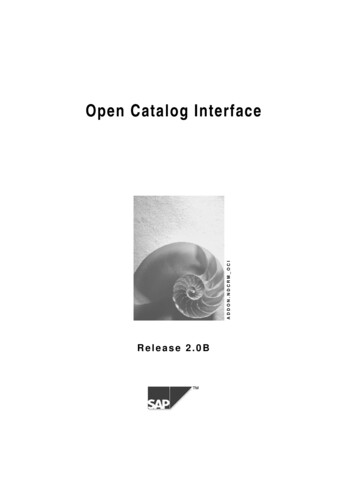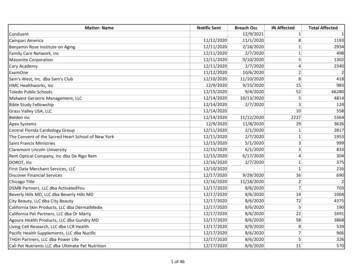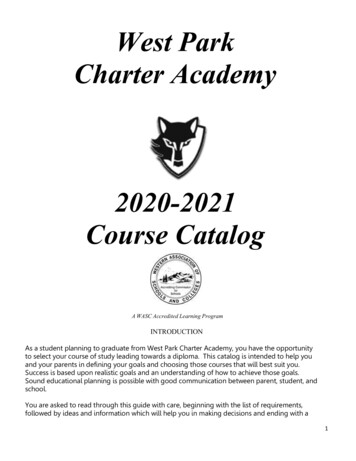
Transcription
West ParkCharter Academy2020-2021Course CatalogA WASC Accredited Learning ProgramINTRODUCTIONAs a student planning to graduate from West Park Charter Academy, you have the opportunityto select your course of study leading towards a diploma. This catalog is intended to help youand your parents in defining your goals and choosing those courses that will best suit you.Success is based upon realistic goals and an understanding of how to achieve those goals.Sound educational planning is possible with good communication between parent, student, andschool.You are asked to read through this guide with care, beginning with the list of requirements,followed by ideas and information which will help you in making decisions and ending with a1
form on which you can write your plans. Do not concern yourself with specific course titles atthis time. There will be time and help for that as you register for each semester.Table of ContentsRequirements for Graduation3School Academic Policies and Practices478101213Four – Year Planning GuideCollege Entrance RequirementsHigh School College Preparatory ChecklistCollege Entrance ExaminationsFinancial Aid for CollegeCoursesEnglishMathematicsLife and Physical ScienceSocial StudiesForeign LanguageVisual and Performing Arts15161718192021222325Physical EducationTechnology/VocationalElectivesHigh School College Credit Only CoursesHigh School College Dual Credit CoursesWest Park Charter Academy High SchoolDiplomaRequirements for GraduationIn order to graduate from West Park Charter Academy with a High School Diploma, a student is required2
to successfully complete 220 credits. Each semester class is normally worth 5 credits. Students arerequired to take certain courses during their high school years. Required courses are:SubjectSemestersCreditsEnglish Language ArtsMathematics (20) Algebra (10)864030Life Science (10) Physical Science (10)Civics/Econ (10), US History (10) World History (10)and World Geography (5)420735Foreign Language /Visual Arts420Physical Education/Health425Technology/Vocational(20) Electives (30)1050Total Credits220West Park Charter AcademySchool Academic Policies and PracticesGradesA student receives five semester credits for most classes during a semester in which a passing grade (A,B, C, D) is earned. The cumulative grade point average (GPA) is computed by awarding grade points (A 4,B 3, C 2, D 1).Values of letter grades:A-B : The grades A or B indicate the student is doing work that is recommended for any fouryear college or university.3
C:The grade C indicates satisfactory work in the particular subject on the high schoollevel. This grade is an acceptable grade for college entrance, but not necessarily arecommendation for college entrance.D:The grade D indicates that the student is deficient in knowledge of the subject and theinstructor would not, at this time, expect the student to do well in courses taken later inthe same subject area. A grade of D is not accepted by colleges and universities.F:The grade F indicates the student has not met the minimum requirements setfor the course. Required courses that are failed must be repeated and passed in order to meetgraduation requirements.Incomplete Grade (INC)A semester incomplete (INC) grade may be issued by a teacher when a student has not completed thecourse requirements due to an extended absence or extenuating circumstances. The student will haveup to four weeks to complete the required work and receive a passing grade. An incomplete grade notresolved by that time will be changed to an “F”.Withdrawal (W)If a student is removed from a class for any reason, the grade will show up as a “W” on the report cardand no credit will be issued that semester for the class.Report CardsTwo (2) semester report cards are sent to the parents/students. These grades are officially recorded onthe transcript.Progress ReportsProgress reports will be sent home in the Fall and Spring Semesters.Repeating a CourseA student may repeat a course and substitute a better grade with the following conditions:A student may substitute a grade only once for a particular course and for only one attempt.No additional credit is issued for a repeated course when previous credit was granted.Maximum Credit GuidelinesIt is recommended that students be enrolled in 30 - 35 semester credits. If a student requests additionalcredits (over 35) the teacher will need prior written approval from the High School Counselor. Approvalwill only be given for 10 credits per request. Any credits above 45 will need approval from the Director.College Courses/High School Enrichment ProgramHigh school students may attend college and take courses/receive high school credit after successfullycompleting one semester with satisfactory grades/attendance at West Park Charter Academy. The collegecourse(s) must:*Be approved by the Director*Not be offered at West Park Charter Academyschool calendar)*Be academic & rigorous*Be taken during the 2019-2020 school year (see4
The counselors, teachers, parents/guardians, and students will work together to complete and submit (to theMachado Office):*A High School Enrichment Program Application*A Master Agreement (for the college course/courses)*A course syllabus and/or course description*Official transcripts within 2 weeks of the course endingFor reimbursement of textbooks, the student must have:*Earned a “C” or higher in the course(s)*Submitted a receipt for their book(s)*Submitted their official transcripts within 2 weeks of the course(s) ending**Students who choose to take college courses for college credit will only have to submit a High SchoolEnrichment Program application, and will not be reimbursed for textbooks.Graduation CeremonyStudents must meet all of the requirements for graduation (credits, 90% attendance, and requiredcourses) by the deadline for senior grades to be eligible to participate in the graduation ceremony. Allbooks and materials must be returned to the school and any outstanding debts must be paid.California High School Proficiency Exam (CHSPE)The California High School Proficiency Examination (CHSPE) is a voluntary test that assesses proficiency inthe basic reading, writing, and mathematics skills taught in public schools. Eligible persons who passboth parts of the CHSPE are awarded a Certificate of Proficiency by the State Board of Education. Thetest is given in English only.You may take the CHSPE only if on the test date, you: are at least 16 years old, or have been enrolled in the tenth grade for one academic year or longer, or Will complete one academic year of enrollment in the tenth grade at the end of the semesterduring which the next regular administration will be conducted. (Regular administrations are thefall and spring administrations each school year.)The CHSPE is offered three times a year. There is an administration once in each semester and once inthe summer. There is at least one test administration center in most California counties. A list of thecounties and test centers may be found on the Internet at http://www.chspe.net or in the CHSPEinformation bulletin also available on this Web site.Certificate of ProficiencyCalifornia law requires that the Certificate of Proficiency be equivalent to a high school diploma. Institutions thatare subject to California law and that require a high school diploma also must accept a Certificate of Proficiency.A student who receives a Certificate of Proficiency may, with verified parental approval, leave high schoolearly. The Certificate of Proficiency, however, is not equivalent to completing all course work required forregular graduation from high school. Speak to your school counselor to understand the benefits of theCertificate of Proficiency. If you are planning to continue your studies in a college or university, contactthe admissions office so that you may understand its requirements and whether or not the CHSPE5
certificate will be accepted.Additional information about the CHSPE is located on the Web at: http://www.chspe.net or call (866)342-4773.General Educational Development Test (GED)West Park Charter Academy does not offer the GED test. However a student is eligible to take the GEDthrough the State of California if the student is a resident of California and meets any one of thefollowing criteria: The individual is 18 years of age or older, or within 60 days of his or her 18th birthday (regardlessof enrollment status). The individual must be within 60 days of when he or she would have graduated from high schoolhad the individual remained in school and followed the usual course of study (please note thatexaminees testing under this criteria may not be enrolled in school. The individual is 17 years of age, has been out of school for at least 60 consecutive school days,and a letter of request for the test from the military, a post-secondary educational institution or aprospective employer. The individual is 17 years of age and is incarcerated in a California state or county correctionalfacility. Testing under these conditions must meet all of the following criteria:1. The examinee does not have a realistic chance of completing the requirements for a highschool diploma.2. The examinee has adequate academic skills to successfully complete the GED test battery.3. The examinee understands the options available regarding acquisition of a high schooldiploma, high school equivalency certificate or the high school proficiency certificate, andthe requirements, expectations, benefits, and limitations of each option.4. The examinee has sufficient commitment time left to complete the entire GED testbattery; if released before the test is completed, the examinee may complete testing at anauthorized center.Persons who pass the GED test at age 17 will not receive the equivalency certificate until their 18thbirthday. A letter of intent is issued which states that the certificate is being held pending theexaminee’s 18th birthday.Further information regarding the GED can be obtained on-line at www.cde.ca.govWest Park Charter AcademyFour Year PlanningThese plans are typical of most students to achieve the four goals listed. Some students require modifiedplans to meet specific career or educational goals. Classes in bold print are required at that grade 12th6
CreditsHigh SchoolDiplomaCommunityCollegeCalifornia StateUniversity/Universityof California0-5556-110111-165English 9Algebra IWorld GeographyEarth Science/LabHealthForeign Lang/ArtsPhysical EducationEnglish 10MathematicsWorld HistoryBiology/LabForeign Lang/ArtsPhysical EducationEnglish 11MathematicsUS HistoryTech/Voc.ElectiveEnglish 9Algebra IWorld GeographyEarth Science/LabHealthForeign Lang/ArtsPhysical EducationEnglish 10MathematicsWorld HistoryBiology/LabEnglish 11MathematicsUS HistoryTech/Voc.Foreign Lang/Arts ElectiveEnglish IAlgebra IWorld GeographyEarth Science/LabHealthForeign LanguagePhysical EducationEnglish IIGeometry WorldHistoryBiology/LabForeign LanguagePhysical EducationPhysical EducationEnglish IIIAlgebra IIUS llege PrepElective166-220English I2AmGovt./EconTech/Voc.ElectiveEnglish 12Am ish ses in bold print are required courses at that grade levelCollege Entrance RequirementsThere are three systems of post-secondary education in California:I.Community Colleges:College of the Sequoias, Fresno City, Reedley College, Porterville, West Hills, etc. You must be a highschool graduate, or 18 years of age with a desire to benefit from what the college is offering. A studentmay select one of the following curriculums: Transfer Program:You may complete the first two years of a college program at a community college thentransfer to a 4-year college. Community Colleges work closely with State and University7
College Systems through the transfer program. Associate of Arts Degree Program:2-year program. General education requirements in addition to the specified unitrequirements of a major. Certificate Programs:Vocational courses, such as auto mechanics, bookkeeping, electronics, secretarial, drafting,agriculture, building trades, forestry technician, LVN(nursing), etc. These programs vary fromone semester to four semesters. They are designed to give the student a concentration of skillcourses adequate to provide immediate employment capability in a specialized field.II. California State University (CSU)/University of California (UC):To be minimally eligible for admission to California State University (CSU) and the University of California(UC) students must complete the A-G/College entrance requirements. These courses represent the basiclevel of academic preparation that high school students should achieve to undertake university work.Students must complete these courses with a grade of C or better.AreaSubjectYears2EHistory/Social Science- CSU-1 year of U.S. history or 1 semester of U.S. historyand 1 semester of civics or American government AND 1 year of social science.UC-Two years, including one year of world history, cultures, and historicalgeography and one year of U.S. History or one-half year of U.S. History and onehalf year of civics or American governmentEnglish- Four years of college preparatory English that includes frequentand regular writing, and reading of classic and modern literature.Mathematics- Three years of college preparatory mathematics, including AlgebraI, Geometry, Algebra II, or higher mathematics (4 recommended)Laboratory Science- Two years of laboratory science including a biologicalscience and 1 physical science. UC: must be in at least 2 of these threedisciplines: biology, chemistry, and physics.Foreign Language-Two years of the same language required.FFine Arts-One year including dance, drama/theater, music, or visual art.1GCollege Prep Electives-One year, chosen from additional “a-f” courses beyondthose used to satisfy the requirements above, or courses that have been approvedsolely for use as “g” electives.1ABCD4322III. Private Colleges:California's nonprofit, independent colleges and universities are often referred to as "private." Nonprofit,independent colleges and universities are not state-supported, unlike the University of California, CaliforniaState University, or California Community College systems. Because each nonprofit, independent collegeand university is unique, admission requirements vary. Generally, admission requirements at nonprofit,independent colleges and universities fall into four categories: (1) schools with admission requirementssimilar to the University of California; (2) schools with admission requirements similar to the California StateUniversity system; (3) schools that accept only the top students in the world; and (4) schools with veryspecific requirements. Some of those schools include: Fresno Pacific University, USC, and many religiousbased colleges and universities.8
High School College Preparatory Checklist9th Grade Checklist STUDENT: Enroll in a college preparatory curriculum. You are encouraged to enroll ina math and foreign language class each year that you are in high school. Courses thatyou will need to take are; Algebra I and II, Geometry and 2-3 years of foreignlanguage. STUDENT: Get involved in extracurricular activities, volunteer in your community,9
explore careers and job opportunities in those careers.PARENTS: Talk about college and university opportunities with your children.PARENTS/STUDENT: Take the opportunity and attend ‘College Day’ (college fairs)here at school or in your local community.PARENT/STUDENT: Check with your teacher to make sure you are on track forgraduation. Also check with the counselor to make sure you are taking the requiredacademic classes.STUDENT: Study hard and do well in school - From now on your grades will counttoward college and will show up on your permanent record.STUDENT: Get to know your high school counselor and let them get to know you andyour goals, career aspirations, schools you are considering, etc. Your parents maywant to go along too.10th Grade Checklist PARENTS/STUDENT: Review your 9th and 10th grade courses with your teacher orcounselor to make sure that you have taken, and are taking, the college preparatorycourses required for admissions to a selective university. STUDENT: Continue to maintain “A’s” and “B’s”. STUDENT: You can choose to take the PSAT this year. Speak with your teacher orcounselor about test dates, descriptive questionnaires, registration fees, andregistration fee waivers. PARENTS/STUDENT: Visit local colleges and universities. STUDENT: Use the internet and start looking at colleges through their websites. PARENTS/STUDENT: Start a college savings account and regularly deposit into it.11th Grade Checklist PARENTS/STUDENT: Review your courses with your teacher or counselor to makesure that you have taken, and are taking, the college preparatory courses requiredfor admissions to a selective university. Take solid elective courses (extra math,science, foreign language, etc.). STUDENT: This year’s academic record will go a long way toward either helping orhurting your chances of gaining admissions to your schools of choice. Therefore,make sure to maintain “A’s” and “B’s” in all of your courses. STUDENT: Participate in academic enrichment programs.10
STUDENT: If you have not taken the PSAT in the 10th grade, take the PSAT Octoberof 11th grade because it is the only time students can qualify for the National MeritScholarship Funds. STUDENT: Take the ACT and/or SAT during the spring semester. That way you’llhave at least one score going into your senior year. This also puts you on schools’mailing lists and gives significant information to the schools you are considering. PARENTS/STUDENTS: Visit college campuses. STUDENT: Create a file on colleges and universities that appeal to you. Ask yourhigh school counselor for suggestions as to colleges you should consider. STUDENT: Get to know the admissions criteria for your top schools. Comparerequirements for admissions and financial aid available at each institution.12th Grade Checklist STUDENT: Review all your courses with your teacher or counselor to ensure you havetaken the courses required for admissions. Continue to challenge yourself and takesolid electives. STUDENT: Maintain an “A” or “B” grade point average. PARENTS/STUDENTS: Continue to visit college campuses. STUDENT: Check with counselor for scholarship information. STUDENT: Register and take the earliest SAT and/or ACT if you haven’t already. STUDENT: Apply for admissions and complete any other admissions process such asOrientations, Placement tests, etc. (check and meet all deadlines) PARENTS/STUDENTS: Gather tax and other relevant information and apply forFinancial Aid (after January 1st) no later than March 2nd.College Entrance ExaminationsSAT I & SAT II exams must be taken by the December test date.PSAT/NMSQT: (Preliminary Scholastic Assessment Test/National Merit Scholarship Qualifying Test) assessesreading, math, and writing skills; provides excellent practice for the SAT; and connects students to scholarships andpersonalized online tools. PSAT/NMSQT offers students the opportunity to gain experience taking standardizedcollege admissions exams. For eleventh graders taking the PSAT/NMSQT, the exam can qualify students forNational Merit Scholarship Funds.SAT: (Scholastic Assessment Test) The SAT tests the skills you’re learning in school: reading, writing and math. Yourstrength in these subjects is important for success in college and throughout your life.11
1. The reading section includes reading passages and sentence completions.2. The writing section includes a short essay and multiple-choice questions on identifying errors and improvinggrammar and usage.3. The math section includes questions on arithmetic operations, algebra, geometry, statistics and probability.Each section of your SAT (critical reading, mathematics and writing) will be scored on a 200- to 800-point scale, for apossible total of 2400. Many colleges and universities require the SAT for admission.SAT Subject Tests: (Scholastic Assessment Test) Subject Tests are hour-long, multiple-choice, content-based teststhat allow you to showcase achievement in specific subject areas where you excel. Some SAT Subject Tests haveunique formats and may require use of special equipment (e.g., calculators for Mathematics Level 1 and Level 2 tests,CD players for Languages with Listening tests). These are the only national admission tests where you choose thetests that best showcase your achievements and interests. There are 20 SAT Subject Tests in five general subjectareas: English, history, languages, mathematics and science. Each Subject Test is scored on a scale of 200 – 800.Register on-line @ www.collegeboard.comWest Park Charter Academy School Code is 050932ACT: (American College Testing Program) The exam is divided into four parts: English, Mathematics, Science, andReading. There are four scores for the ACT – one for each of the individual exams. The Composite Score is theaverage of your four test scores, rounded to the nearest whole number. The composite score is the score most oftenused for admission purposes by universities and colleges. The ACT composite score is scored on a scale of 1 – 36. TheACT exam can be used for admission into most universities and colleges.Register on-line @ www.act.orgFinancial Aid for CollegeWhat is Financial Aid?Financial Aid is money that is given, paid or loaned to you to help pay for college. Financial Aid can be:Federal: GrantsFree money that does not have to be paid back. (Pell Grants, Supplemental EducationalOpportunity Grants (FSEOG), Teacher Education Assistance for College and Higher Education (TEACH) Grants)Work-study Salary for students to work part-time during the school year adding to their financialaid package to help pay for their schooling.12
LoansMoney borrowed and must be repaid with interest. (Federal Perkins Loan Program & William D.Ford Federal Direct Loan Program)State:GrantFree money that does not have to be paid back. (Cal Grants A, B and C, Cal Grant A and BCompetitive Awards). Fee WaiversFee Waiver permits enrollment fees to be waived. (Board of Governor’s Fee Waiver)Independent: Scholarship Free money awarded to students for academic achievement or many other factors such asspecial talents. How do I apply for this money?FAFSATo apply for any money, you must complete the Free Application for Federal Aid (FAFSA) online. Application muststndbe completed between January 1 and March 2 senior year of high school. This is the priority deadline forconsideration for the CAL Grants and other institutional awards.Dream ActUndocumented AB 540 students must NOT complete the FAFSA (Free Application for Federal Student Aid) becausethey are not eligible for Federal financial aid. Instead they must complete the California Dream Act Application in orderto receive financial scholarships and state financial aid.How can I apply for the FAFSA?You can apply online at www.fafsa.ed.gov. You will also need to apply for a pin to sign your FAFSA electronically athttps://pin.ed.gov.How can I apply for the Dream Act?You can apply online at https://dream.csac.ca.gov/.How much does a college education cost?Costs vary from institution to institution. Public institutions are usually less expensive than private institutions.Private colleges tend to charge more, because they receive less financial support from state and local governmentthan do public colleges.TuitionThe amount of money a college charges for instruction and use of some facilities, such alibraries.FeesCharges that cover costs generally not associated with student’s course load (athleticactivities, student activities, clubs, and special events).OtherExpensesInclude room and board (housing and food), books, supplies,transportation and other miscellaneous costs.13
Who can I call if I have questions?You can call the West Park Charter Academy counselor, or the Federal Student Aid Information Center, 1-800-4FED-AID(1-800-433-3243) or 319-337-5665. Information is also available on their web site address:https://fafsa.ed.gov/help.htm.Financial Aid Information:Fast Web (Free Internet Scholarship Search)www.studentservices.com/fastwebCalifornia Student Aid Commission www.csac.ca.govU.S. Dept. of Education’s Student Guide to Financial Aid www.ed.govFinancial Aid Information Page www.finaid.orgCareer Exploration:California Career Centerwww.calcareercenter.orgCalifornia Career Zonewww.careerzone.orgENGLISH LANGUAGES ARTSEnglish IA (a-g)Fulfills UC/CSU “b” requirement Grade Level: 9Credits: 5Course ID: 101This course is designed to meet the needs of college-bound students.Students will study various elements of literature and read avariety of fiction (novel, short story, drama, poetry) and non-fiction(biography, autobiography, essay, report) selections. Extensivewriting will reinforce both understanding of literature andorganization of ideas. Numerous opportunities will be provided fororal expression. Vocabulary, spelling, punctuation, and grammarare stressed.English IB (a-g)Credits: 5Course ID: 101.5Prerequisite: English IA. This second semester course is thecontinuation of English I A.English IIA (a-g)Fulfills UC/CSU “b” requirement Grade level: 10Credits: 5Course ID: 102Prerequisite: English IA and IB. This class extends the college boundstudent’s knowledge and instruction in all literary elements andgenres covered in English I. Reading, writing, listening, andspeaking are integrated into the total curriculum. Vocabulary,spelling, punctuation, and grammar will be stressed.English IIB (a-g)Credits: 5Course ID: 102.5Prerequisite: English IA, IB and English IIA. This second semestercourse is the continuation of English II A.14
English III A (a-g)English 9 BFulfills UC/CSU “b” requirement Grade level: 11Credits: 5Course ID: 103Credits: 5Prerequisite: English IA, IB, and English IIA, IIB. This courseoffers a chronological study of American literature. Major formsof literature representing America’s best writers through the agesand cultural and historical implications are studied. Grammar,vocabulary skills, and expression through various writing genres aredeveloped and emphasized.English III B (a-g)Credits: 5Course ID: 103.5Prerequisite: English IA, IB, English IIA, IIB and English IIIA. This second semester course is the continuation of English IIIA.English IV A (a-g)Fulfills UC/CSU “b” requirement Grade level: 12Credits: 5Course ID: 104Prerequisite: English IA, IB, English IIA, IIB and English IIIA,IIIB. This course offers a chronological study of England’sliterature, both oral and written, providing opportunities to developcommunication skills and for students to reflect their understandingof the western cultures, philosophies, and values.Course ID: 108.5Prerequisite: English 9 A. This second semester course is thecontinuation of English 9 A.English 10 AGrade Level: 10Credits: 5Course ID: 109This course extends the student’s knowledge and instruction in allliterary elements and genres covered in English 9. Reading, writing,listening, and speaking will be integrated into the total curriculum.Vocabulary, spelling, punctuation, and grammar will be stressed.English 10 BCredits: 5Course ID: 109.5Prerequisite: English 10 A. This second semester course is thecontinuation of English 10 A.English 11 AGrade Level: 11Credits: 5Course ID: 110This course offers a thorough chronological study of Americanliterature. All major forms of literature representing America’sbest writers through the ages and the cultural and historicalimplications are studied. Grammar, vocabulary skills, andexpression through various writing genres are developed andemphasized.English 11 BCredits: 5English IV B (a-g)Credits: 5Course ID: 104.5Prerequisite: English IA, IB, English IIA, IIB, English IIIA, IIIB andEnglish IV A. This second semester course is the continuation ofEnglish IV A.English 9 AGrade Level: 9Credits: 5Course ID: 108Students will study the various elements of literature, read avariety of fiction (novel, short story, drama, poetry), and non-fiction(biography, autobiography, essay, report) selections. Extensivewriting will reinforce both understanding of literature andorganization of ideas. Numerous opportunities will be provided fororal expression. Vocabulary, spelling, punctuation, and grammarare stressed.Course ID: 110.5Prerequisite: English 11 A. This second semester course is thecontinuation of English 11 A.English 12 AGrade Level: 12Credits: 5Course ID: 111This course offers a chronological study of England’s literature,both oral and written, providing opportunities to developcommunication skills and for students to reflect theirunderstanding of the western cultures, philosophies, and values.English 12 BCredits: 5Course ID: 111.5Prerequisite: English 12 A. This second semester course is thecontinuation of English 12 A.ALGEBRA/MATHEMATICSAlgebra IA (a-g)Algebra IIA (a-g)Fulfills UC/CSU “c” requirement Grade Level: 9-12Credits: 5Course ID: 204Fulfills UC/CSU “c” requirement Grade Level: 9-12Credits: 5Course ID: 206This course investigates number properties. The basic operationsof addition, subtraction, multiplication, and division aregeneralized. Topics as linear and quadratic equations, inequalities,graphing and factorization are presented.Prerequisite: Algebra I. This course reviews concepts learned inAlgebra I and extends the student’s math experience to suchtopics as linear and quadratic functions, graphing, and systems ofequations, radicals and complex numbers.Algebra IB (a-g)Algebra IIB (a-g)Credits: 5Course ID: 204.5Prerequisite: Algebra IA. This second semester course is thecontinuation of Algebra I A.Credits: 5Course ID: 206.5Prerequisite: Algebra II A. This second semester c
3. The examinee understands the options available regarding acquisition of a high school diploma, high school equivalency certificate or the high school proficiency certificate, and the requirements, expectations, benefits, and limitations of each option. 4. The examinee has sufficient commitment time left to complete the entire GED test


